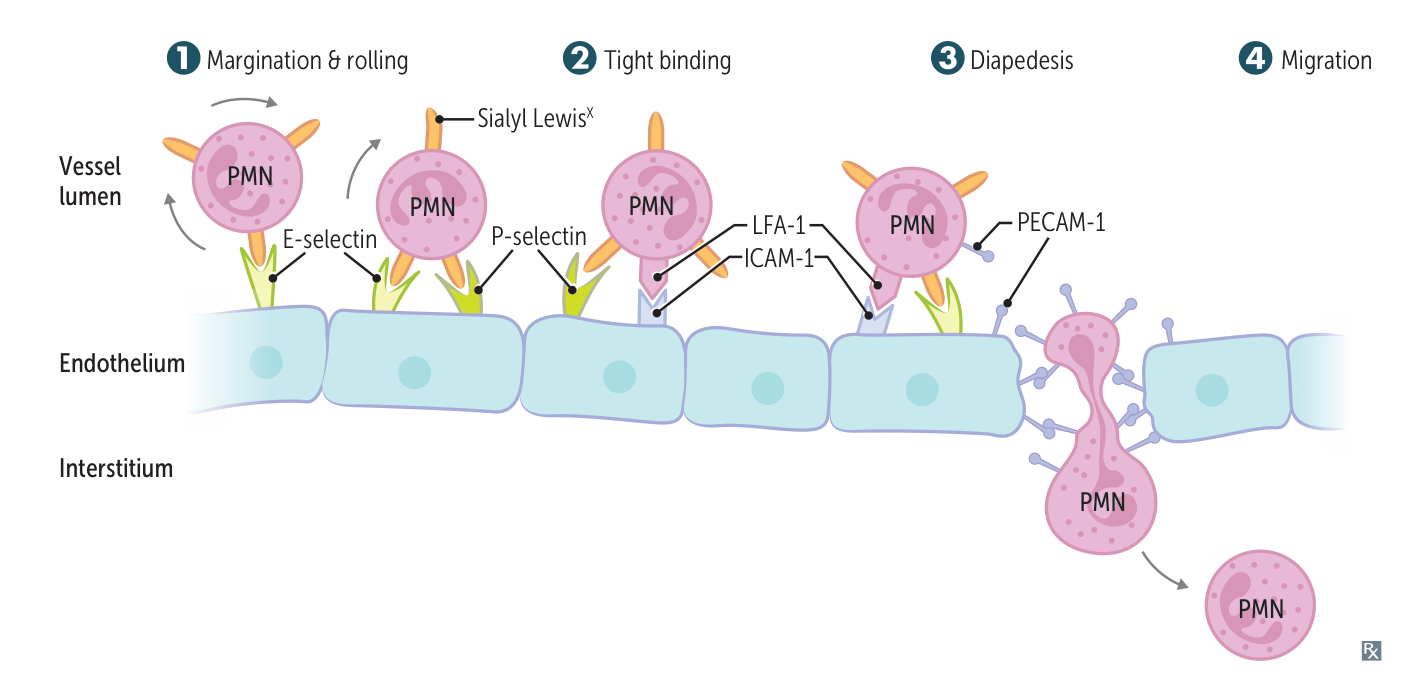
Mnemonic
RoLLing = SiaLyL Lewis on Leukocyte, binds to E-seLectin & P-seLectin on endothelium. DiaPEdesis = PECAM binding to PECAM. Knowing 1st step and 3rd step, I just remember CD18-ICAM/VCAM as step in middle by default.
- Margination & Rolling: In the bloodstream, leukocytes move to the periphery of vessels (margination). Inflamed endothelium expresses P-selectin and E-selectin. These bind to Sialyl Lewis X (S-Lex) on leukocytes, causing them to slow down and roll along the vessel wall.
- Adhesion (Tight Binding): Chemokines presented on the endothelial surface activate leukocyte integrins. This causes a conformational change in integrins, leading to high-avidity binding. ICAM-1 (Intercellular Adhesion Molecule-1) on the endothelium binds firmly to LFA-1 integrins (CD11/CD18) on leukocytes.
- Transmigration (Diapedesis): Leukocytes squeeze between endothelial cells to exit the blood vessel. This process is mediated by PECAM-1 (Platelet Endothelial Cell Adhesion Molecule-1), which is present on both leukocytes and endothelial cells.
- Migration: Once in the interstitium, leukocytes move toward the site of injury by following a chemotactic gradient. Key chemoattractants include C5a, IL-8, Leukotriene B4 (LTB4), and bacterial products.
Margination
- Definition: a process by which leukocytes are distributed peripherally along the endothelial surface
- Mechanism: The two main mechanisms that allow for margination are rouleaux formation and dilation of post-capillary venules.
Rolling
- Definition: a transient weak interaction of leukocytes with endothelial cells that causes them to move slowly along the blood vessel periphery in areas of inflammation in preparation for adhesion
- Mechanism: mediated by adhesion molecules (selectins)
- On endothelial cells
- P-selectin
- Stored in Weibel-Palade bodies
- Histamine-mediated release within the endothelium in response to inflammation
- E-selectin: released in response to inflammatory mediators such as TNF and IL-1
- Other: GlyCAM-1, CD34
- P-selectin
- On leukocytes
- Neutrophils and other leukocytes express Sialyl-LewisX and L-selectin, respectively.
- Deficiency of the adhesion molecule Sialyl-LewisX causes Leukocyte adhesion deficiency type 1 type 2.
- On endothelial cells
Tip
Selectins are molecules that allow leukocytes to select the place of their migration (weak binding), while integrins are molecules that integrate (strong binding) the leukocytes with the endothelial cells.
Leukocyte adhesion
- Definition: the firm binding of leukocytes to endothelium prior to migrating out of the vasculature
- Mechanism: mediated by adhesion molecules
- On endothelial cells
- Intercellular adhesion molecule (ICAM, also called CD54)
- Vascular adhesion molecule (VCAM, also called CD106)
- Both upregulated by TNF and IL-1
- On neutrophils and lymphocytes
- Neutrophils: lymphocyte function-associated antigen-1 (LFA-1)
- Belongs to β2-integrin family
- Composed of CD18 and CD11a
- Binds to ICAM
- Lymphocytes and monocytes β1-integrin (also called VLA-4) binds to VCAM
- Expression of integrins is activated by leukotriene B4 (LTB4) and C5a.
- The deficiency of a CD18 integrin subunit causes Leukocyte adhesion deficiency type 1.
- Neutrophils: lymphocyte function-associated antigen-1 (LFA-1)
- On endothelial cells
Diapedesis (transmigration)
- Definition: the transmigration of leukocytes across endothelial barriers (can occur paracellularly or transcellularly)
- Mechanism
- Leukocytes leave the blood vessel by moving between endothelial cells.
- Neutrophils release type IV collagenase, which dissolves the basement membrane and allows them to exit the interstitial space.
- Requires expression of platelet endothelial cell adhesion molecule-1 (PECAM-1, also called CD31), an endothelial cell adhesion molecule (ECAM) on neutrophils, endothelial cells, and platelets
Migration
- Definition: the process by which leukocytes travel through the interstitium to the site of inflammation after leaving the blood vessels
- Mechanism: Occurs via chemotaxis, which is mediated by chemoattractants
- Leukotrienes: e.g., LTB4
- Platelet-activating factor (PAF)
- Chemokines: e.g., IL-8
- Kallikrein: a serine protease enzyme that activates bradykinin and regulates blood pressure
- Complement fragments, e.g., C5a